An uncontrolled intersection is generally used where low vehicle volume roads meet in a T intersection; no control is implemented and normal give way rules apply. A priority control is generally used for intersections as vehicle volumes increase. At priority intersections, the side road(s) has either a ‘Give Way’ or a ‘Stop’ control sign.
Priority and uncontrolled intersections are the most common intersections in the transport network in New Zealand. Pedestrians must give way when crossing at priority and uncontrolled intersections when there is no formal pedestrian crossing, eg. zebra crossing. The figures below are examples of uncontrolled and priority intersections.
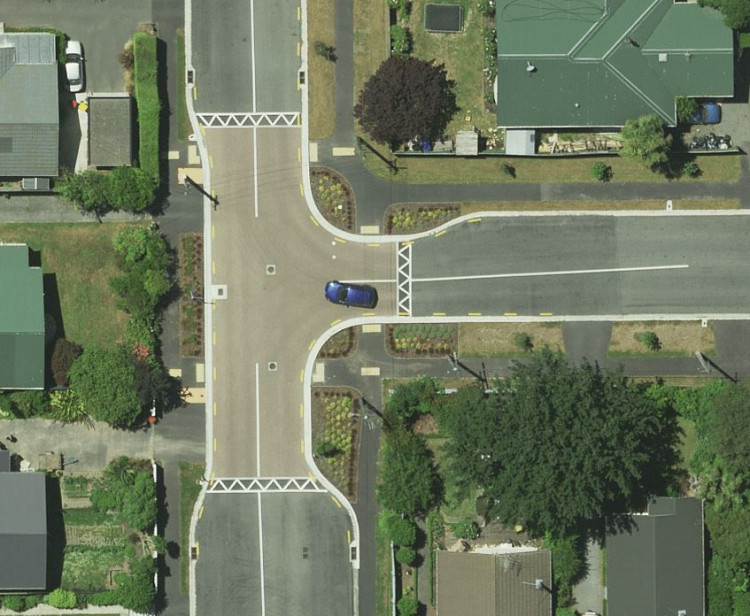
Uncontrolled intersection. (Source: Canterbury Maps)
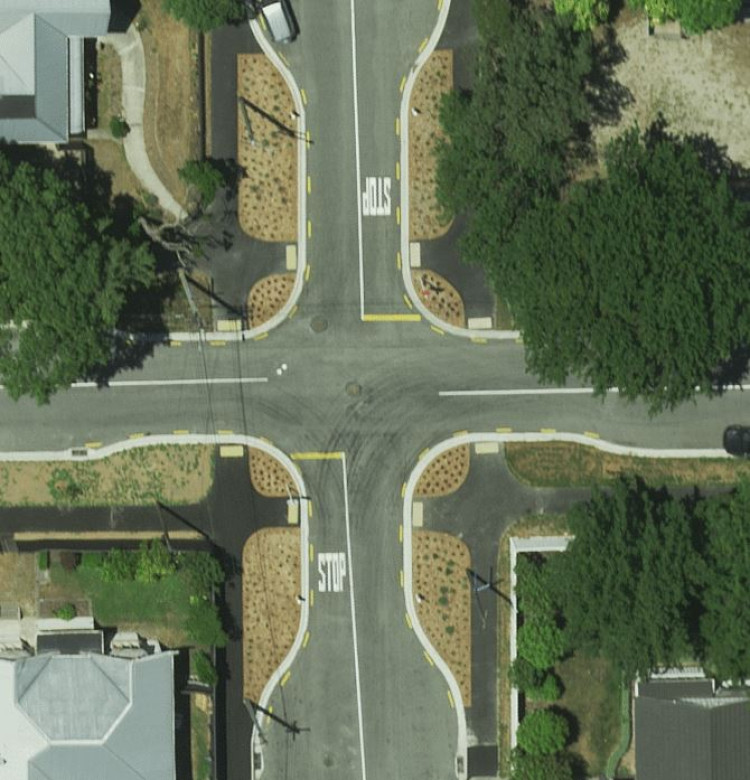
Priority intersection (STOP). (Source: Canterbury Maps)
Uncontrolled and priority intersections have the following benefits and implications for pedestrians crossing.
When vehicle volumes are above about 750 vehicles in the peak hour on the major road (approximately 7,500 vehicles per day) it becomes increasingly difficult for pedestrians to find a suitable gap to cross, and therefore their waiting delay becomes unsatisfactory. Therefore, pedestrian median islands are recommended where pedestrians need to cross a major road with vehicle volume of more than about 750 vehicles per hour (7,500 vehicles per day). Low vehicle volume environments (less than 750 vehicles in the peak hour) should have kerb extensions to minimise the crossing distances for pedestrians.
PNG: Crossing aids and pedestrian delay
The kerb and channel of any footpath must permit the safe and easy passage from kerb to kerb of any mechanical conveyance normally and lawfully used by a disabled person.(external link)
NZ Local Government Act 1974, s331(2)(external link)
Pedestrians crossing at uncontrolled or priority intersections are required to give way to vehicles unless there is a zebra crossing present, according to current NZ Road Code.
Besides the general intersection design principles, the key considerations to provide safe and convenient pedestrian movements at uncontrolled and priority intersections are:
PNG: Intersection design principles
PNG: Vertical deflection devices
PNG: Street lighting at crossings
PNG: Designing for blind and low vision people

Priority intersection with footpaths and kerb crossings on pedestrian desire lines. (Source: Canterbury Maps)
Refer to Design elements section below for more detailed guidance on specific treatments.
Specific treatments can assist pedestrians to cross at uncontrolled and priority controlled intersections or give them priority to cross. The combination of infrastructure depends on the context of the intersection. Further detail and examples for each treatment are provided below.
The shape and layout of kerb extensions will usually reduce crossing distances for pedestrians. The shape of the kerb extensions will depend on the size of turning vehicles using the intersection. Ideally the kerb ramps should be placed on straight sections of the kerb extension for ease of applying tactile indicators that are legible.
Pedestrian refuge islands can assist pedestrians to cross at an intersection as they make the crossing task easier. However, they can result in crossings being located off pedestrians’ natural desire lines particularly if space is required for right turning vehicle movements as shown in the example figure below. Pedestrian refuge islands are usually required if the vehicle volumes on the major road exceed about 750 vehicles per hour (approximately 7,500 vehicles per day).
PNG: Crossing selection process
PNG: Pedestrian / median refuges
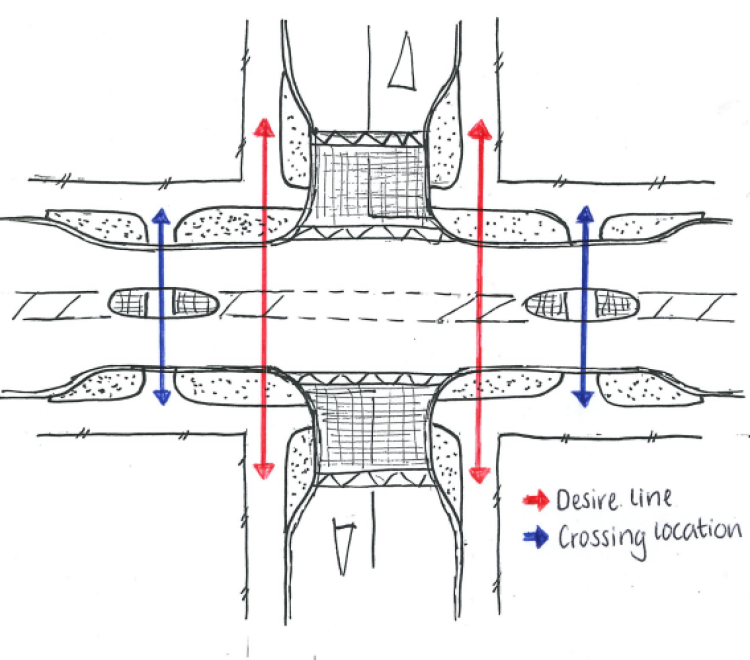
Layout showing how providing a refuge island can move pedestrians off their desire line indicated by the red arrows. (Source: Ward et al 2020)
A raised platform or raised table can be installed across a side road incorporating a place for pedestrians to cross the side road. Although in NZ the road rules still afford drivers the priority (pedestrians must give way), the platform serves to reduce vehicle speeds, and provides a more comfortable crossing for pedestrians as they do not have to negotiate kerb ramps down onto the roadway, then back onto the footpath. As pedestrian platforms do not give pedestrians priority, they can be unsuitable for some pedestrians. These treatments can operate as courtesy crossings if the vehicle speeds are low and the street context means drivers are likely to give way to pedestrians waiting to cross.
An example of a pedestrian platform across a side road is shown in the photo below. Note, the platform colour is distinct from the footpath to make it clear that pedestrians do not have priority.
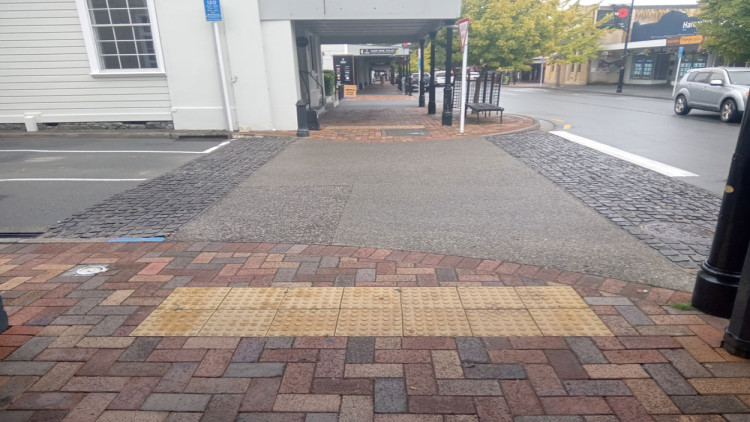
Pedestrian platform across a side road, Nelson (Photo: Mark Edwards)
Pedestrian platforms are most appropriate where pedestrian volumes are higher than turning vehicle demand, and vehicle demand is modest.
Pedestrian platforms often include kerb extensions to narrow the throat of the intersection thereby reducing the crossing distance for pedestrians and to encourage slower vehicle speeds. The pedestrian platform should be located to meet the pedestrian desire line across the side road.
It is important that pedestrians do not falsely perceive the treatment as a continuation of the footpath. To avoid this misunderstanding:
The table below describes the design elements for pedestrian platforms at side roads.
Table: Design elements for pedestrian platforms across a side road
|
Element |
Requirement |
Additional information |
|
Platform height |
100mm recommended |
75mm may be considered where site constraints and traffic composition suggest a lower height profile is suitable (eg bus routes).
|
|
Platform length |
Minimum length 6m if vehicles may need to stop on the platform (for example, while waiting to enter the vehicles flow). |
This length enables a standard passenger vehicle to bring both sets of wheels up onto the platform at the same time which makes the vertical deflection more comfortable for vehicle occupants. |
|
Approach ramp gradient |
At least 1:15 for 30km/h platform speed, steeper ramps are more effective in slowing vehicle speeds. |
Ramp grade should be designed to achieve the required Safe System impact speed prior to entering the conflict point. |
|
Departure ramp gradient |
Maximum 1:35 |
Where the platform is located on an undivided road, the departure ramp gradient will be the same as the approach ramp gradient. |
|
Ramp markings |
The ramp face visible to approaching drivers should be marked with hump ramp markings. |
Further information can be found in the TCD Manual Part 5 |
|
Surfacing / colour |
The platform surface should be clearly distinguishable from the footpath and ideally the same material as the road. |
Also refer to guidance on coloured surfacing. Coloured surfacing principles best practice guidance note [PDF, 2 MB] |
|
Tactile indicators |
Warning indicators are required and directional indicators may be necessary. |
Further information is provided in |
|
Signage |
W14-4 Hump warning sign as per TCD Manual Part 5
|
|
|
Lighting |
In accordance with AS/NZS 1158.3.1: 2020 |
Further information can be found in(external link) |
A typical layout of a pedestrian platform across a side road, with a refuge island, including the appropriate signs and markings arrangement is shown in Figure 13-1 of the TCD Manual Part 4 (draft for consultation)
Vertical deflection can be applied to an entire intersection. This is known as a raised intersection. Raised intersections can slow vehicle speeds and increase driver awareness of the intersection (eg through different surfacing) however they do not provide priority to pedestrians and are therefore not suitable for some pedestrians and in some contexts. Higher vehicle flows can make it difficult for pedestrians to find a suitable gap in which to cross. In these situations, the inclusion of pedestrian crossing and/or crossing aids (eg pedestrian refuges) in addition to the raised intersection is recommended as shown in the second figure below.
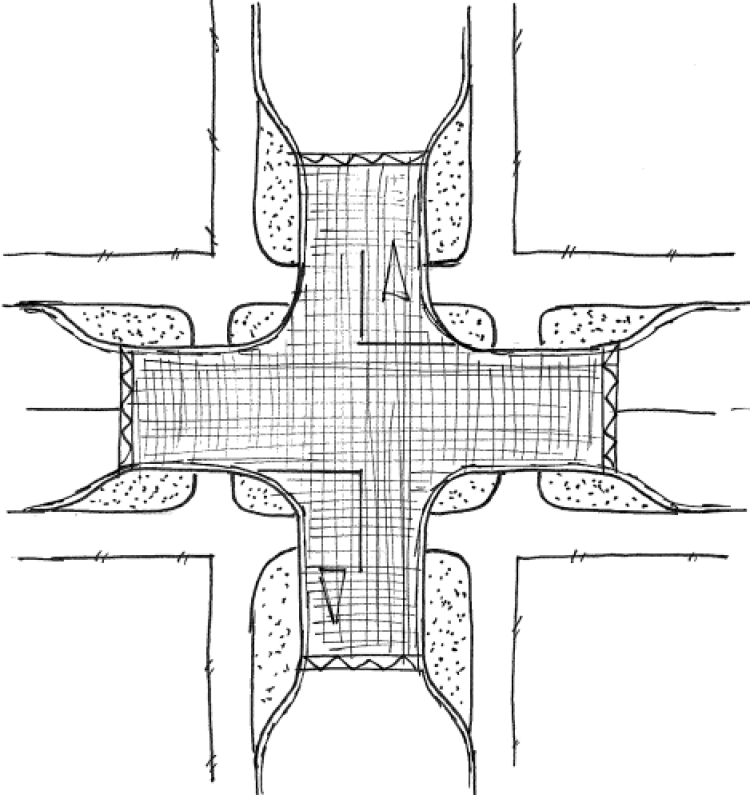
Recommended layout for low vehicle volumes on major road. (Source: Ward et al 2020)

Recommended layout for medium to high vehicle volumes on major road. (Source: Ward et al 2020)
The signs and markings for raised uncontrolled or priority controlled intersections are provided in Section 13.4 of the TCD Manual Part 4 which also includes a typical layout in Figure 13-2. Note this layout does not show the pedestrian crossing aids such as tactile indicators that should be provided. It is important to ensure that pedestrians with low vision do not inadvertently enter the intersection through the use of tactile indicators or other detectable means. Depending on the context and pedestrian demand there also may be a need for other crossing aids such as pedestrian refuges and kerb extensions to be provided at the raised intersection.
TCD Manual Part 4 (draft for consultation)
Zebra crossings may be provided near uncontrolled and priority controlled intersections to assist pedestrians to cross. These can be particularly useful where pedestrian volumes are higher, for example in town and activity centres. It is recommended these are raised zebra crossings or they are placed on a raised intersection to ensure the vehicle speeds are low (<30km/h) which ensures they are Safe System aligned.
A zebra crossing close to an intersection means a driver may be focusing on the intersection rather than the crossing. Therefore, it is important to ensure that visibility to and through the intersection for drivers and pedestrians is adequate. In addition, slower vehicle speeds give drivers more time to react and safely stop to avoid a collision.

Zebra crossings at a raised priority intersection, Tauranga. (Photo: Matthew Noon)
Note: small paving blocks may make detecting the tactile paving more difficult for people who are blind or have low vision.
The guidance on when to use a zebra crossing and the location considerations in the Crossings section are also applicable for those near intersections.
Also, Section 4.10 of the TCD Manual Part 4 lists some matters that should be considered regarding the placement of zebra crossings near intersections and the traffic control device requirements.
TCD Manual Part 4 (draft for consultation)
Ward, J, Dance, G, and Kumar, R (2020). Making raised intersections work for walking, Transportation Group conference
[1] Corben, B. (2020). Integrating Safe System with Movement and Place for Vulnerable Road Users, AP-R611-20, p19